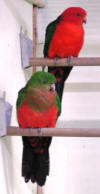. king parrot

Aviary Notes: Level Of Knowledge Required: Beginner / Intermediate / Advanced / Specialist Breeders Only. Government Regulations & By-Laws: Refer to " Government Laws " web page. Housing Requirements: Refer to " Housing Birds " web page for general details on the housing of Australian Parrots or read on for specific details for this parrot. The King Parrot is a large bird and prefer a large aviary. Minimum aviary length should be 3 metres (10 feet) but an aviary of 5 - 6 metres (16 - 20 feet) long is ideal. Width 1200 mm (4 feet) x 2100 mm (7 feet) high is recommended. To encourage the pair to breed, the log or nest should be hung in a sheltered darkened part of the aviary. This is usually at the back of the aviary under non-transparent roofing material. Non-toxic leafy branches can be placed in the aviary for the birds to chew up. This will entertain the birds, help minimize boredom and give the birds some beak exercise. Natural branches of various diameters, and placed at various angles, can be used for perches. These natural perches may be chewed by the birds and may need to be replaced regularly. The birds may chew any flowers and fruiting bodies on the branches. Diet / Feeding: Refer to " Feeding Birds " web page for general details on the feeding of Australian Parrots or read on for specific details for this parrot. Natural diet in the wild includes seeds, fruits, berries, nuts and blossoms. In the aviary the King Parrot requires: Basic seed is Small parrot mix or Budgie mix with sunflower seed, safflower and plain canary seed. A variety of fruits, nuts, green leafy vegetables, and a variety of seasonally available vegetables are essential in a balanced diet. Almonds are commonly used. Corn-on-the-cob is a parrot favourite. Sprouted seed or soaked seed if available. Soaked mung beans can be offered. Seeding grasses will be eagerly devoured. Fruits and vegetables can make up more than 50% of the birds daily food intake. Seasonally available fruits and vegetables as well as thawed frozen vegetables should be offered to the birds each day. Vegetables to include green leafy vegetables such as silverbeet, spinach or endive. Good quality dry dog food can be offered. Wholemeal or multigrain bread can be offered. Commercial parrot pellets can form part of a balanced diet. Nesting: A basic overview only. Dimensions are typical / average and can vary widely, influenced by the owner's preferences and the birds preferences. Parent bird's preferences can also be influenced by the size and type of nest-box / log in which the bird was hatched and reared. If space allows, offering a choice of sizes and types of logs or nest-boxes, and placed in various locations within the aviary, can allow the parent birds to make their own choice. Once a pair has chosen a specific nest-box/log and been successful in it, offer that one to them each breeding season. Try and keep that one for their exclusive use. Once a pair has chosen its log or nest-box, the other ones can generally be removed. If the "spare" boxes are to be removed and moved to another flight, ensure the log / nest box is cleaned to ensure the receptacle has the minimal contamination of mites, parasites and pathogens. All Australian parrots will breed in hollow logs.
In the wild the King Parrot will generally choose vertical or near vertical hollows in which to nest, often in an eucalypt tree. Timber nest-boxes generally require a climbing structure attached inside the box below the entrance hole. Both logs and nests need an entrance hole/opening about 100mm (about 4 inches) from the top. Many species of parrots like the entrance hole to be just big enough to squeeze through. More details on parrot nestboxes/logs and a selection of parrot nestbox/log photos can be found on the "nests", "parrot nests" and "parrot nestbox photos" web pages. Click on "Up" then "Nests" then "parrot nests" and "parrot nestbox photos" in the navigation bars. Breeding: Egg Colour White. Clutch/s per year 1 or 2. Eggs per nest 4 - 6. Incubation approx. 20 days. Fledge approx. 5 weeks. Independent approx. another 2 - 3 weeks. If the parent birds are not going to lay another clutch, the young are often left with the parent birds, however if any aggression is shown to the young, the young must immediately be removed. As with many other parrots, if space allows, the young birds can be housed beside a breeding pair. The successful adult breeding pair will educate the young birds on the social and breeding skills they will need to learn to be a compatible pair and successful parents. The hen King parrot is the important factor in the compatibility of a pair. The hen chooses her partner so if she does not find the cock bird to her liking, there is little chance of a successful breeding. If sufficient young birds are available, young birds that can choose their own mate usually become more compatible adults and better breeders than those that have their partner chosen for them. Birds that are destined for the pet or companion bird trade are often removed from the nest at about 3 weeks of age and hand raised. It is common practise to place a closed metal ring on the young bird while it is in the nest. Artificial incubation and hand rearing or fostering will not be covered on this web site. It is too complex and diverse in nature to be attempted here. Health Issues: Refer to "Avian Health Issues" web page for information and references.
General References: Refer to references listed on "Book References" web page. Specific References:
|